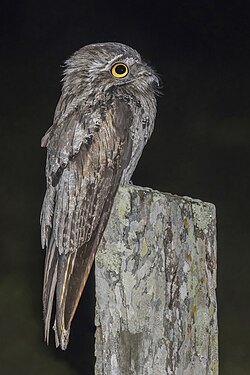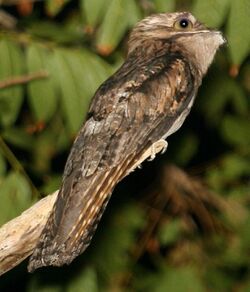Biology:Northern potoo
| Northern potoo | |
|---|---|

| |
| Nyctibius jamaicensis mexicanus, Belize | |
| Scientific classification | |
| Domain: | Eukaryota |
| Kingdom: | Animalia |
| Phylum: | Chordata |
| Class: | Aves |
| Clade: | Strisores |
| Order: | Nyctibiiformes |
| Family: | Nyctibiidae |
| Genus: | Nyctibius |
| Species: | N. jamaicensis
|
| Binomial name | |
| Nyctibius jamaicensis (Gmelin, JF, 1789)
| |

| |
The northern potoo (Nyctibius jamaicensis) is a nocturnal bird belonging to the potoo family, Nyctibiidae. It is found from Mexico south to Costa Rica, and on the islands of Jamaica and Hispaniola (in the Dominican Republic and Haiti). It was formerly classified as a subspecies of the common potoo (Nyctibius griseus) but is now usually treated as a separate species based on differences in vocalizations.
Taxonomy
The northern potoo was formally described in 1789 by the German naturalist Johann Friedrich Gmelin in his revised and expanded edition of Carl Linnaeus's Systema Naturae. He placed it with all the nightjar like species in the genus Caprimulgus and coined the binomial name Caprimulgus jamaicensis.[1] Gmelin based his description on earlier accounts of the bird in Jamaica, including Hans Sloane's "Wood owle" published in 1725 and John Latham's "Jamaican goatsucker" published in 1783.[2][3] The northern potoo is now one of the seven potoos placed in the genus Nyctibius that was introduced in 1816 by the French ornithologist Louis Pierre Vieillot.[4][5] The genus name is from Ancient Greek nuktibios meaning "night-feeding", from nux night and bios "life". The specific epithet is from the toponym, Jamaica, the type locality.[6]
The northern potoo was formerly classified as a subspecies of the common potoo (Nyctibius griseus),[7] but since 1995 it has usually been treated as a separate species based on the differences in vocalizations.[8]
Subspecies
Five subspecies as recognised:[5]
- Nyctibius jamaicensis lambi Davis, J, 1959 – west Mexico
- Nyctibius jamaicensis mexicanus Nelson, 1900 – east, south Mexico to Honduras
- Nyctibius jamaicensis costaricensis Ridgway, 1912 – Costa Rica
- Nyctibius jamaicensis jamaicensis (Gmelin, JF, 1789) – nominate subspecies - Jamaica
- Nyctibius jamaicensis abbotti Richmond, 1917 – Hispaniola and Gonâve Island
Description
It is a fairly large bird with a length of 38-46 centimetres. It has a long tail, long pointed wings, large head, very short legs and a small bill with a large gape. It is most commonly seen perched motionless in an upright position on branches or posts. The plumage is grey-brown with an intricate pattern of black, grey and cream markings. The cheeks are pale with a dark malar stripe below them. The large eye has a yellow iris which can shine red in light at night. The bird's calls are hoarse and guttural. The common potoo is virtually identical in appearance, but has a very different voice consisting of a series of mournful, wailing whistles. The great potoo is larger and paler, with no dark malar stripe.
The song is a "rough, squalling kwaaah, kwa-kwa-kwa". It also makes "an abrupt, emphatic rrah!" and "a barking alarm call".[9]
Distribution and habitat
The five subspecies are distributed across Central America and the Caribbean. It mainly occurs in lowland areas where it inhabits woodland and scrubland with clearings and farmland with scattered trees. It is sometimes seen around golf courses and urban areas. It is a occasional visitor to Puerto Rico and its presence in Cuba is unconfirmed.
Behavior and ecology
Breeding
A single egg is laid on a broken branch with no nest material used. Both parents are involved in incubating the egg and feeding the young bird.
Food and feeding
It feeds on large insects such as moths or beetles. It hunts from a perch, sitting and waiting for prey then sallying out to catch it in flight.
Status
The IUCN has assessed the northern potoo as being of Least Concern. It has a large range and a population exceeding 50,000 mature individuals, though that number is believed to be decreasing.[10]
The Mopan people believe that if a northern potoo (Template:Lang-myn) flies over a person's house repeatedly at night, someone in that family will die. To prevent this, they chase the birds away with lighted sticks, whose embers are said to repel the bird.[11]
References
- ↑ Gmelin, Johann Friedrich (1789) (in Latin). Systema naturae per regna tria naturae : secundum classes, ordines, genera, species, cum characteribus, differentiis, synonymis, locis. 1, Part 2 (13th ed.). Lipsiae [Leipzig]: Georg. Emanuel. Beer. p. 1029. https://www.biodiversitylibrary.org/page/2656524.
- ↑ Sloane, Hans (1725). A Voyage to the Islands Madera, Barbados, Nieves, S. Christophers and Jamaica : with the natural history of the herbs and trees, four-footed beasts, fishes, birds, insects, reptiles, &c. of the last of those islands. 2. London: Printed for the author. p. 295. https://www.biodiversitylibrary.org/page/188466.
- ↑ Latham, John (1783). A General Synopsis of Birds. 2, Part 2. London: Printed for Leigh and Sotheby. p. 591, No. 2, Plate 57. https://www.biodiversitylibrary.org/page/33730675.
- ↑ Vieillot, Louis Pierre (1816) (in French). Analyse d'une Nouvelle Ornithologie Élémentaire. Paris: Deterville/self. p. 38. https://gallica.bnf.fr/ark:/12148/bpt6k9745205x/f44.item.
- ↑ 5.0 5.1 Gill, Frank; Donsker, David; Rasmussen, Pamela, eds (January 2022). "Frogmouths, Oilbird, potoos, nightjars". IOC World Bird List Version 12.1. International Ornithologists' Union. https://www.worldbirdnames.org/new/bow/nightjars/.
- ↑ Jobling, James A. (2010). The Helm Dictionary of Scientific Bird Names. London: Christopher Helm. pp. 277, 210. ISBN 978-1-4081-2501-4.
- ↑ Peters, James Lee, ed (1940). Check-List of Birds of the World. 4. Cambridge, Massachusetts: Harvard University Press. p. 181. https://www.biodiversitylibrary.org/page/14476652.
- ↑ Monroe, B.L.; Banks, R.C.; Fitzpatrick, J.W.; Howell, T.R.; Johnson, N.K.; Ouellet, H.; Remsen, J.V.; Storer, R.W. (1995). "Fortieth Supplement to the American Ornithologists' Union Check-List of North American Birds". The Auk 112 (3): 819–830. https://academic.oup.com/auk/article/112/3/819/5168113.
- ↑ Gu, D.; Behrstock, R.A.; Schulenberg, T.S. (2020). Schulenberg, T.S.. ed. "Northern Potoo (Nyctibius jamaicensis), version 1.0". Birds of the World (Ithaca, NY, USA: Cornell Lab of Ornithology). doi:10.2173/bow.norpot1.01. https://doi.org/10.2173/bow.norpot1.01. Retrieved 8 July 2022.
- ↑ Cite error: Invalid
<ref>tag; no text was provided for refs namedIUCN - ↑ Hull, Kerry; Fergus, Rob (June 2009). "An ethnoornithological approach to human-bird relations among the Mopan Maya of Belize". Conference Proceedings of the 8th Annual Hawaii International Conference on Social Science: 17–31. http://hicsocial.org/SOC2009.pdf.
- Clements, James F. (2007) The Clements Checklist of Birds of the World, 6th ed., Cornell University Press, Ithaca, New York.
- Downer, Audrey & Sutton, Robert (1990) Birds of Jamaica: A Photographic Field Guide, Cambridge University Press, Cambridge.
- Garrigues, Richard & Dean, Robert (2007) Birds of Costa Rica, Christopher Helm, London.
- Raffaele, Herbert; Wiley, James; Garrido, Orlando; Keith, Allan & Raffaele, Janis (2003) Birds of the West Indies, Christopher Helm, London.
External links
- Mangoverde World Bird Guide: Northern Potoo Nyctibius jamaicensis.
- Northern potoo photo gallery VIREO
- Photo-High Res; Article sos-wildlifejamaica
- Photo-Medium Res; Article tropicalbirding
Wikidata ☰ Q898991 entry
 |




